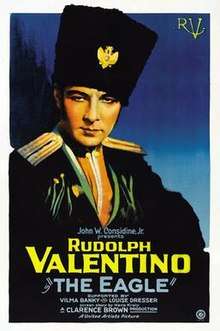The Eagle (1925 film)
The Eagle is a 1925 American silent film directed by Clarence Brown and starring Rudolph Valentino, Vilma Bánky, and Louise Dresser.[1] Based on the posthumously published 1841 novel Dubrovsky by Alexander Pushkin,[2] the film is about a lieutenant in the Russian army who catches the eye of Czarina Catherine II. After he rejects her advances and flees, she puts out a warrant for his arrest, dead or alive. When he learns that his father has been persecuted and killed, he dons a black mask and becomes an outlaw. Prints currently exist in the film holdings of EmGee Film Library and in private film collections.[1][2] Black Eagle does not exist in the novel and was inspired by the performance of Douglas Fairbanks as Zorro in The Mark of Zorro.[3]
| The Eagle | |
|---|---|
 Theatrical release poster | |
| Directed by | Clarence Brown |
| Produced by | John W. Considine Jr. Joseph M. Schenck |
| Written by | Hans Kraly George Marion Jr. |
| Based on | Dubrovsky by Alexander Pushkin |
| Starring | |
| Music by | Michael Hoffman Carl Davis Lee Erwin |
| Cinematography |
|
| Edited by | Hal C. Kern |
Production company | Art Finance Corporation |
| Distributed by | United Artists |
Release date |
|
Running time | 80 minutes |
| Country | United States |
| Language | English intertitles |
Plot
Vladimir Dubrovsky (Valentino), a Lieutenant serving in the Imperial Guard of the Russian army, comes to the notice of the Czarina (Louise Dresser) when he rescues Mascha (Vilma Bánky), a beautiful young lady, and her aunt trapped in a runaway stagecoach. He is delighted when the Czarina offers to make him a general, but horrified when she tries to seduce him. He flees and the Czarina puts a price on his head.
Soon afterwards, he receives a letter from his father informing him that the evil nobleman Kyrilla Troekouroff (James A. Marcus) has taken over his lands and is terrorizing the countryside. Hurrying home, Vladimir learns that his father has died. Vowing to avenge his father and help the victimized peasantry, he adopts a black mask and becomes the Black Eagle, a Robin Hood figure. Discovering that Kyrilla is Mascha's father, he takes the place of a tutor who has been sent for from France, but not previously seen by anyone in the household. Vladimir is thus able to become part of Kyrilla's household.
As Vladimir's love for Mascha grows, he becomes more and more reluctant to continue seeking revenge against her father, and the two eventually flee the Troekouroff estate. Vladimir is captured by the Czarina's men, but the Czarina, once determined to have him executed, has a last-minute change of heart, and she allows Vladimir, given a new French name, and Mascha to leave Russia for Paris.
Cast
- Rudolph Valentino as Lt. Vladimir Dubrovsky
- Vilma Bánky as Miss Mascha Troekouroff
- Louise Dresser as The Czarina, Catherine 2nd
- Albert Conti as Captain Kuschka
- James A. Marcus as Kyrilla Troekouroff
- George Nichols as Judge
- Carrie Clark Ward as Aunt Aurelia
- Spottiswoode Aitken as Dubrovsky's Father (uncredited)
- Agostino Borgato as Priest (uncredited)
- Mario Carillo as Marcel Le Blanc, French Tutor (uncredited)
- Gary Cooper as Masked Cossack (uncredited)
- Jean De Briac as Small Role (uncredited)
- Otto Hoffman as Man Who Gets Purse Stolen (uncredited)
- Eric Mayne as Official Asking for Signature (uncredited)
- Russell Simpson as The Eagle's Lieutenant (uncredited)
- Mack Swain as Innkeeper (uncredited)
- Gustav von Seyffertitz as Court Servant at Dinner (uncredited)[1][2]
Reception
Valentino's previous few films had not been particularly well received, but The Eagle proved a strong comeback for him, getting good reviews from the critics, doing well at the box office, and proving popular with both male and female fans - although it was not as successful as his next movie, Son of the Sheik.[4]
The Eagle is also notable in cinematic history for its famous extended tracking shot of the food-laden table in the banquet scene.
The film is recognized by American Film Institute in these lists:
- 2001: AFI's 100 Years...100 Thrills – Nominated[5]
References
- "The Eagle (1925)". The New York Times. Retrieved September 16, 2012.
- "The Eagle". Silent Era. Retrieved September 16, 2012.
- [Reid, John Howard. Silent Movies & Early Sound Films on DVD: New Expanded Edition. Lulu.com, 2011. ISBN 9780557433353 pp. 91-92
- Balio, Tino (2009). United Artists: The Company Built by the Stars. University of Wisconsin Press. ISBN 978-0-299-23004-3. p56
- "AFI's 100 Years...100 Thrills Nominees" (PDF). Retrieved August 20, 2016.
External links
| Wikimedia Commons has media related to The Eagle (1925 film). |
- The Eagle on IMDb
- The Eagle at the TCM Movie Database
- The Eagle at AllMovie
- The Eagle is available for free download at the Internet Archive